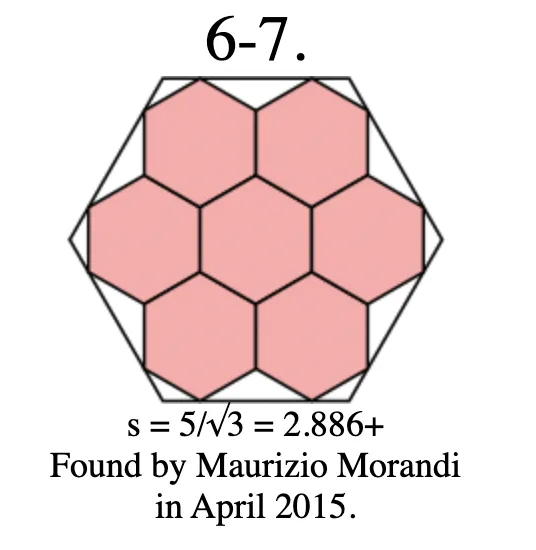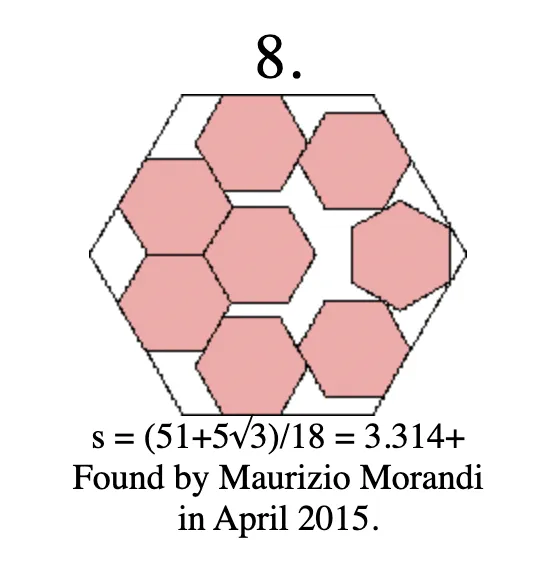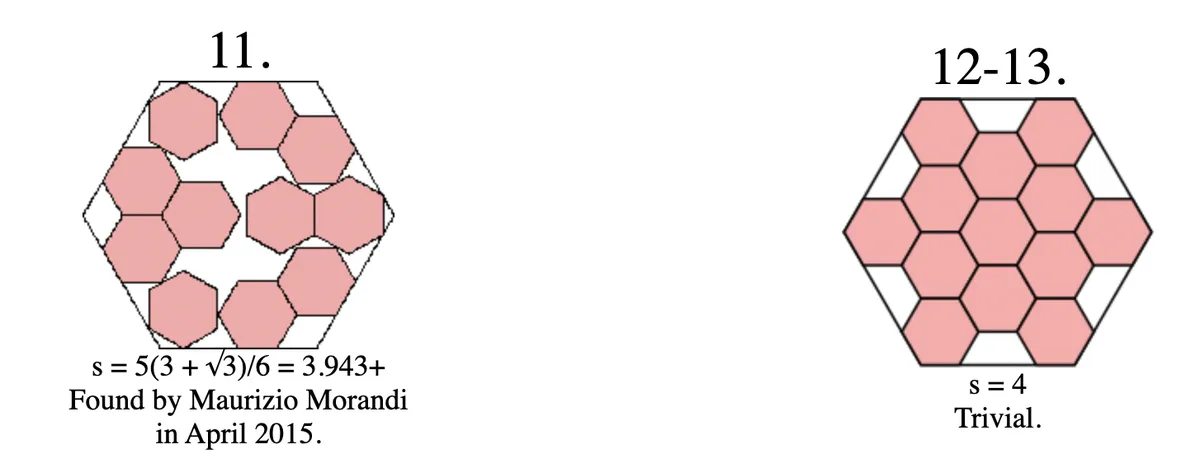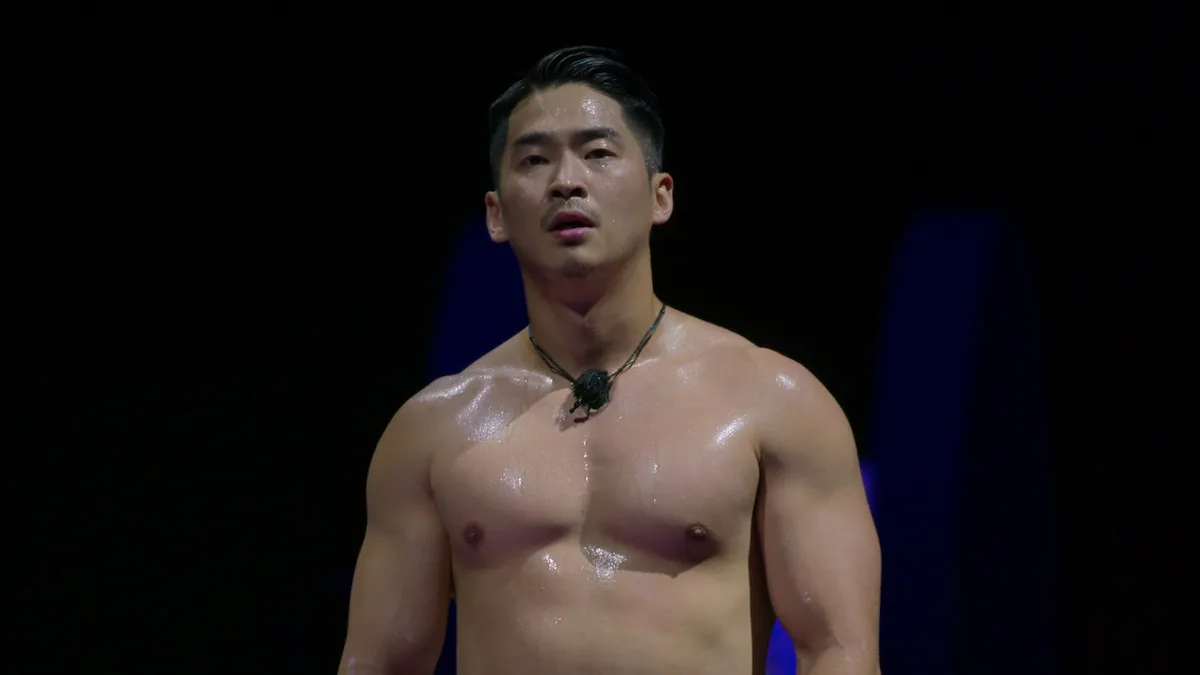I. Harmony vs Efficiency
Humans trust symmetry because it feels like intelligence made visible. Our perceptual system treats harmony as a proxy for correctness. This heuristic works in low-dimensional settings but fails as complexity scales. To see the failure with full clarity it helps to examine a domain where optimality is measurable with mathematical exactness: the regular-hexagon packing problem.
Consider the sequence of discoveries documented by Erich Friedman and refined through decades of work by independent geometers. For small numbers of unit hexagons the optimal packings are symmetric. They carry a natural sense of “rightness.” They are solutions that do not merely satisfy the constraint but satisfy the aesthetic instincts of the solver.
Maurizio Morandi’s 2015 co…
I. Harmony vs Efficiency
Humans trust symmetry because it feels like intelligence made visible. Our perceptual system treats harmony as a proxy for correctness. This heuristic works in low-dimensional settings but fails as complexity scales. To see the failure with full clarity it helps to examine a domain where optimality is measurable with mathematical exactness: the regular-hexagon packing problem.
Consider the sequence of discoveries documented by Erich Friedman and refined through decades of work by independent geometers. For small numbers of unit hexagons the optimal packings are symmetric. They carry a natural sense of “rightness.” They are solutions that do not merely satisfy the constraint but satisfy the aesthetic instincts of the solver.
Maurizio Morandi’s 2015 construction for packing 6 and 7 unit hexagons inside a larger hexagon demonstrates this interplay of necessity and elegance. The pattern is nearly crystalline. Symmetry aligns with density. Efficiency expresses itself as beauty.

But once the system reaches 8 unit hexagons the symmetry begins to fracture. Morandi’s own optimal configuration for 8 abandons the perfect honeycomb intuition. He introduces a tilt that looks wrong to the unaided eye. Yet the tilt is not an accident. It is the shape of the optimum.

The break becomes decisive in the 11- and 12-packing problems. Morandi’s 2015 solutions were state-of-the-art for years. They held the record because they were the best constructions humans could imagine under the pressure of aesthetic bias. They look structured because the human solver continued to value structure.

Then AlphaEvolve arrived. It had no preference for symmetry. No aesthetic prior. No instinct to preserve harmony. It explored the configuration space without prejudice and discovered shapes that looked malformed compared to the human lineage. But these shapes were denser. They beat Morandi’s best-known constructions. They pushed the side-length bound downward.

The contrast is instructive. Humans gravitate toward harmonious answers because our neural architecture encodes symmetry as cognitive relief. Algorithms do not. As the dimensionality of a problem increases the probability that the true optimum looks aesthetically pleasing approaches zero. Beauty fails as a heuristic. Symmetry becomes a trap.
The packing problem creates a clean abstraction of a far broader truth: in complex systems the optimal solution often looks like a violation of the intuitively optimal one.
II. Narratives Beaten Into You
An objective function defines what counts as progress. In mathematics it is explicit. In human life it is usually inherited. People imagine they choose their goals, but the goals are installed by exposure patterns. Social media is engineered to rewrite your objective function without your consent.
Instagram optimizes for engagement. Engagement optimizes for emotional velocity. Emotional velocity disguises itself as purpose. After a sequence of fitness reels the mind anchors on a new metric: attainability of the physique on the screen. After a sequence of trading reels the mind replaces its prior with a desire for volatility-derived wealth. The feed induces mimetic gradients. It is optimization by suggestion.
This produces a false sense of agency. You feel motivated but the motivation was seeded. You pursue goals that did not originate in your reflective equilibrium. You sense a desire but cannot distinguish whether it is endogenous or manufactured.
The same mechanism shapes more subtle aspirations. People chase linear career narratives because they resemble Euclidean paths. They pursue symmetrical relationships because storybook symmetry is easier to imagine than real intimacy. They set aesthetic goals in place of functional ones because aesthetics resolve uncertainty.
This is the psychological equivalent of assuming the best packing must be symmetric because symmetric packings look right. A narrative that feels right replaces an objective function that is right.
III. The Golden Boy

Physical 100 revealed how deeply people confuse aesthetic symmetry with actual advantage. From the opening episodes the audience gravitated toward Yun Sung-bin, the Olympic skeleton racer known as “the Tiger.” He had the physique, the explosiveness, the charisma, and the narrative clarity that fit the cultural template of a champion. His mere presence created a gravitational field. Viewers projected inevitability onto him. He was the symmetric solution to a problem they had not even modeled. He was the peak aura farmer.
Yet aura-farming was not the objective function of the competition.

The show’s final winner, Woo Jin-yong, received almost no narrative spotlight. He was quiet, understated, and radically non-mythic. He lacked the aura that makes crowds assign destiny. But he possessed the properties the contest actually evaluated: sustained metabolic output, recovery under repeated load, grip endurance, lactate tolerance, and the ability to maintain composure across heterogeneous tasks. These are traits systematically trained in crossfit, not traits that map onto visual presence or narrative charisma.
The Tiger fit the story. Jin-yong fit the physics.
Most people mispredict outcomes because they optimize for narrative salience rather than underlying mechanics. They mistake visibility for competence, projection for capability, aura for advantage. The crowd backed the beautifully symmetric answer because it aligned with their bias. Reality selected the asymmetric one because it aligned with the true objective.
The golden boy is the embodiment of collective aesthetic instinct. The winner is often the person who violates that instinct.
IV. Affirmations
- The vertebrate retina routes signals backward through layers that appear inefficient but yield extraordinary fidelity.
- Bacterial chemotaxis uses stochastic switching that violates aesthetic expectations but guarantees environmental navigation.
- Deep learning models form internal geometries that look chaotic yet outperform hand-designed features built for elegance.
- Randomized algorithms like Quickselect beat deterministic ones through irregular execution paths.
- The Nash equilibria of many real markets emerge from asymmetric strategies rather than symmetric cooperation.
- The Manhattan grid looks ordered but the highest productivity clusters arise in zones of spontaneous irregularity.
- Protein folding landscapes produce shapes that appear messy but are global-energy minima.
- Ant colony foraging finds near-optimal routes through distributed, asymmetric signaling.
- Many of Euler’s deepest results came from arguments so irregular contemporaries dismissed them until the proofs held.
- High-frequency trading firms exploit microstructure inefficiencies no narrative trader even perceives.
- Cultural golden ages emerge from nonlinear exchanges, not from coordinated aesthetic programs.
- Scientific breakthroughs often come from immigrants and outsiders whose trajectories violate academic symmetry.
- Immune repertoires are built through random VDJ recombination rather than curated design.
- The parietal cortex integrates sensorimotor information using maps that distort geometry to optimize use.
- The industrial revolution emerged from heterogeneous local tinkering, not from coherent national strategy.
- Evolutionary game theory shows that asymmetric strategies win in repeated Prisoner’s Dilemma settings.
- Simulated annealing deliberately injects disorder to escape symmetric traps.
- Innovation clusters like Silicon Valley formed through path dependence rather than planned harmony.
- Stable ecological networks exhibit asymmetric trophic flows rather than symmetric predator-prey cycles.
- Compression algorithms with maximal efficiency produce outputs that look random rather than patterned.
These examples are not decorative. They form a distributed argument: efficiency evolves through asymmetry.
V. Mechanistic Cringe

AlphaEvolve succeeded because it does not possess the human instinct for legibility. It explores without the burden of taste. It mutates without concern for appearances. It refines without needing its intermediate states to look right. It is willing to search the regions humans avoid because those regions feel computationally or aesthetically barren. Its solutions outperform ours because it is indifferent to embarrassment.
To optimize your own life you need something analogous. You need to drop the aesthetic constraint. You need to run searches that look socially unaligned. You need to explore ideas and paths that appear irregular to others. You need to ignore the instinct to preserve symmetry in your career, relationships, or personal trajectory. You need to treat your objective function as a mathematical object rather than a narrative one.
Cringe is the visible signature of moving along a gradient you chose rather than one installed in you. It is the cost of running an optimization that does not reference the perceptual biases of others.
Cringe is what optimization looks like when you optimize without prejudice for yourself.
Footnotes:
#alphaevolve #asymmetry [#complex systems](https://shvbsle.in/blog/?q=complex systems) #cringe [#geometric packing](https://shvbsle.in/blog/?q=geometric packing) [#instagram influence](https://shvbsle.in/blog/?q=instagram influence) [#life strategy](https://shvbsle.in/blog/?q=life strategy) [#mimetic desire](https://shvbsle.in/blog/?q=mimetic desire) [#objective functions](https://shvbsle.in/blog/?q=objective functions) #optimization #philosophy [#physical 100](https://shvbsle.in/blog/?q=physical 100) [#symmetry bias](https://shvbsle.in/blog/?q=symmetry bias)